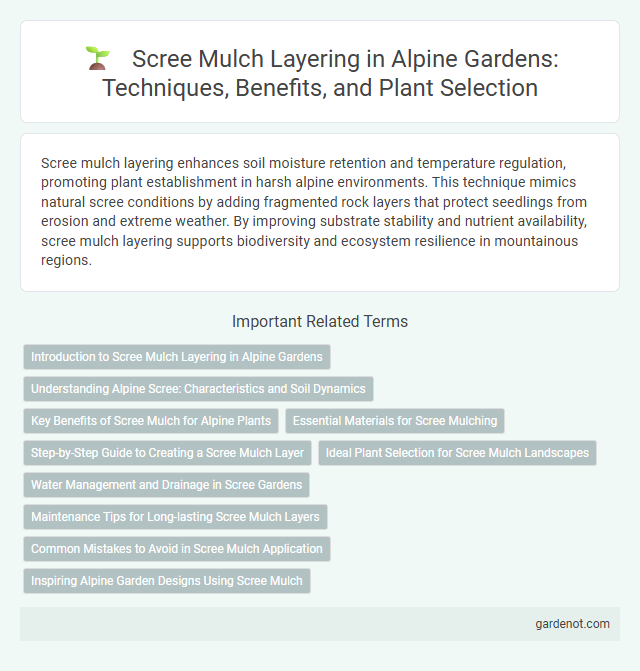Scree mulch layering enhances soil moisture retention and temperature regulation, promoting plant establishment in harsh alpine environments. This technique mimics natural scree conditions by adding fragmented rock layers that protect seedlings from erosion and extreme weather. By improving substrate stability and nutrient availability, scree mulch layering supports biodiversity and ecosystem resilience in mountainous regions.
Introduction to Scree Mulch Layering in Alpine Gardens
Scree mulch layering in alpine gardens mimics natural rock debris to enhance soil drainage and temperature regulation, promoting healthy root systems for drought-resistant plants. This technique involves placing coarse gravel or small stones in layers to replicate scree slopes, supporting moisture retention while preventing erosion in high-altitude environments. Incorporating scree mulch layering optimizes microhabitats critical for the survival of specialized alpine flora.
Understanding Alpine Scree: Characteristics and Soil Dynamics
Alpine scree consists of loose, angular rock fragments that create a permeable, well-drained substrate with minimal organic matter, influencing soil moisture retention and temperature regulation. Scree mulch layering mimics this natural process by applying coarse rock fragments as a protective layer to enhance soil aeration and reduce erosion on slopes. Understanding the dynamics of mineral composition, particle size distribution, and moisture flux in alpine scree is essential for optimizing plant root stability and nutrient availability in harsh mountain environments.
Key Benefits of Scree Mulch for Alpine Plants
Scree mulch layering enhances water retention and drainage, creating an ideal microenvironment for alpine plants to thrive in harsh mountainous conditions. It provides insulation against extreme temperature fluctuations, protecting roots from freezing and overheating. The mineral-rich composition of scree mulch also supplies essential nutrients, promoting robust growth and resilience.
Essential Materials for Scree Mulching
Scree mulch layering requires essential materials such as angular gravel, coarse sand, and fine crushed stone to mimic natural alpine scree conditions. These components ensure optimal drainage, prevent soil erosion, and provide a stable base for alpine plants to thrive. Incorporating organic matter like pine needles or bark chips enhances moisture retention while maintaining the scree's characteristic porosity.
Step-by-Step Guide to Creating a Scree Mulch Layer
Scree mulch layering involves placing a coarse, rocky substrate mixed with organic material to mimic natural alpine scree environments, enhancing drainage and root protection. Start by clearing the planting area and laying a base of large, angular stones to create pockets for moisture retention. Follow with alternating layers of finer gravel and organic mulch, ensuring gradual particle size reduction to stabilize soil and support alpine plant roots effectively.
Ideal Plant Selection for Scree Mulch Landscapes
Ideal plant selection for scree mulch landscapes includes drought-tolerant species with deep root systems, such as Sedum, Sempervivum, and alpine saxifrage, which thrive in well-draining, rocky substrates. These plants enhance soil stability while minimizing erosion on steep slopes by anchoring mulch layers effectively. Incorporating native alpine flora adapted to extreme temperature fluctuations and low nutrient availability optimizes long-term sustainability and biodiversity.
Water Management and Drainage in Scree Gardens
Scree mulch layering enhances water management by promoting efficient drainage and reducing soil erosion in alpine scree gardens. The coarse, angular rock fragments facilitate rapid water percolation while retaining necessary moisture for alpine plants. This natural filtration system prevents waterlogging and supports a stable microclimate essential for scree-adapted vegetation.
Maintenance Tips for Long-lasting Scree Mulch Layers
Regularly removing accumulated debris and weeds prevents nutrient competition and maintains soil aeration in scree mulch layers. Applying a thin top-up of scree stones annually replenishes lost material while preserving the natural drainage properties essential for alpine plants. Monitoring moisture levels ensures the mulch does not become compacted, promoting healthy root development and long-lasting scree layer benefits.
Common Mistakes to Avoid in Scree Mulch Application
Overapplying scree mulch can suffocate alpine plants by limiting air circulation and water infiltration, while using improperly sized mulch particles disrupts root growth and drainage. Avoid layering scree mulch too thickly, as this can promote fungal diseases and soil compaction, hindering plant health. Ensure uniform distribution to prevent uneven moisture retention and temperature fluctuations that stress delicate alpine species.
Inspiring Alpine Garden Designs Using Scree Mulch
Scree mulch layering enhances moisture retention and prevents soil erosion, creating ideal conditions for alpine plants to thrive in rock garden designs. This technique mimics natural scree slopes, fostering improved drainage and root aeration essential for drought-tolerant species like saxifrages and sedums. Incorporating scree mulch in alpine garden designs promotes biodiversity and aesthetic appeal through its textured, layered appearance.
Scree mulch layering Infographic

 gardenot.com
gardenot.com